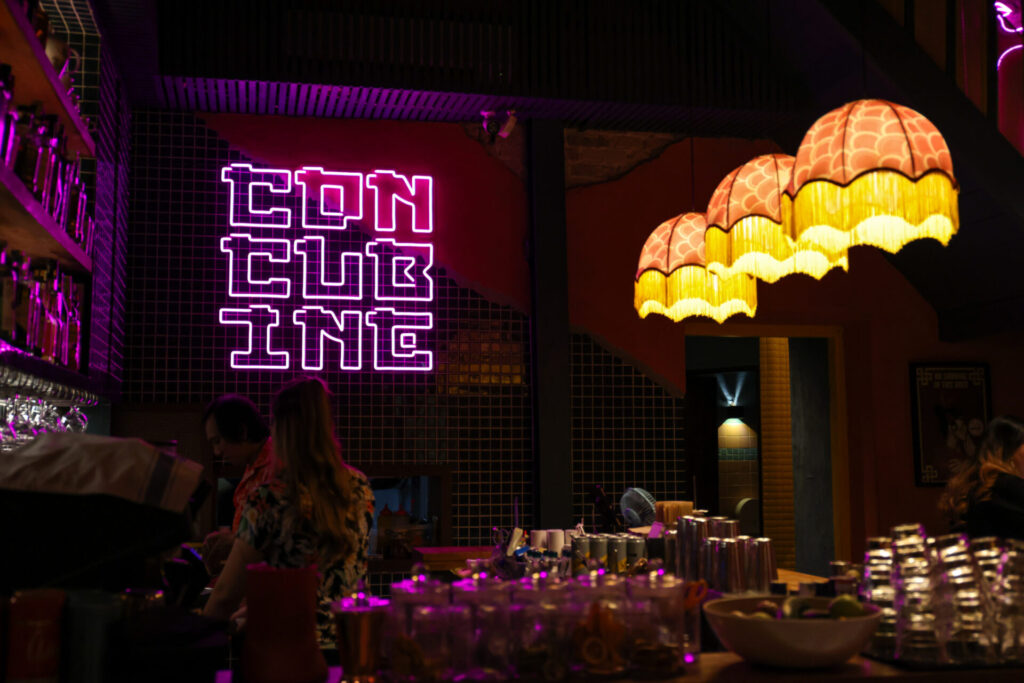A raft of unconventional cocktail bars is pouring new life into Kuala Lumpur’s once-dilapidated Chinatown
Kuala Lumpur’s Chinatown originated in 1870 and later established itself as a settlement for Chinese immigrants during the tin rush. As wealth grew, merchants built shophouses and, for a time, the community thrived. But as KL modernised, and the mining industry declined in the 1980s, the area fell into disrepair and disrepute. Fast forward forty years and it’s clear that times are changing
Her House: Surrounded by Chinatown’s oldest businesses
Standing at the entrance to Her House is a bit like being on the edge of a portal to another world. Magic mirrors and neon lights create a heady illusion that’s certain to confuse patrons after a cocktail or two. It is a surprising discovery at the top of an ancient stairwell that the bar shares with some of Chinatown’s oldest businesses: a dental clinic, a hair-waving saloon and a mole removal specialist.
“Guests have asked us if the shops around us are real,” Roy Leong, 38-year-old co-owner of Her House, laughs. “Sometimes people think we’ve staged it to look this way, like a museum, but it’s all authentic.” Leong should know. He grew up near Kuala Lumpur’s Chinatown district and went to school a few blocks away. “You used to be able to hear the sounds of mahjong being played from all of these old streets,” Leong recalls, “but times changed and, for years, people stopped coming here. It’s good to see new generations re-discovering it.”
Her House opened in January 2022, three months after Malaysia lifted movement control restrictions. Located in a derelict unit in a century-old shophouse, once a mahjong café, Leong transformed the space with plush velvet furnishings and psychedelic murals. It became an instant hit with the social media crowd. “Concepts can be a bit more daring in Chinatown,” confesses Leong, “it’s one of the things that attracted us here.”

G-String and Concubine: Risqué concepts that are a nod to Chinatown’s past
Daring is right. A couple of blocks away from Her House, on Jalan Petaling, a street known for its plethora of counterfeit goods, you will find a risqué little speakeasy called G-String.
Tucked inside the rafters of a shoplot, G-String is deliberately salacious, filled with naughty neon signs, provocative murals and patrons who line up at the bar to order suggestively-named cocktail drinks.
On Lorong Panggung, a laneway of restored shoplots a short walk away, is Concubine, a cocktail bar which pays tribute to the neighbourhood’s murky past of vice, opium and prostitution.
Concubine is part of Kwai Chai Hong, an enclave of narrative murals in a once-uninviting back alley and one of Chinatown’s recent revitalisation projects. It aims to transport visitors back to the 1960s, the era Zeen Chang, one of the project’s pioneers, calls “Chinatown’s golden age”.
Kwai Chai Hong was completed in 2019, as was the restoration of the nearby Rex Cinema, a 1940s movie theatre turned derelict backpackers’ hostel, which is now an impressive arts and exhibition space. Projects like these have accelerated the transformation of KL’s Chinatown, paving the way for a wave of new cocktail bars to create a wonderland of hidden establishments and speakeasies.

Rust: Stripped-back interior belies a colourful past
It isn’t all eyebrow-raising names and flamboyant interiors. A couple of blocks away, on Jalan Petaling, Rust is a quietly understated bar which opened in May 2022. It features a stripped-back interior of exposed brick and crumbling plaster that belies its colourful past.
“We know there was a brothel here at some point,” says 32-year-old Haniff Yon, Rust co-owner and bartender. Yon has worked in bars all over the world, including a spell as a mixologist on a cruise liner.
“These buildings all have that kind of history. That’s part of the reason we ended up keeping a lot of the original features of the shophouse and going with a minimalist, industrial look. We also just wanted a really chill vibe. I always liked Chinatown because it’s more relaxed than Bukit Bintang and more informal than downtown. It’s good to see the nightlife scene growing here.”

Penrose: Small, ambitious and elevated
Further breaking the mould is Penrose, a sophisticated little space, seating just 25 people, which opened at street-level on Jalan Petaling in the summer of 2022. It is named after mathematician and physicist Roger Penrose and a sister venue to Wildflowers (located next door) and Merchant’s Lane, two of Chinatown’s more established venues.
“Our concept is elevated and intimate,” says co-founder and head bartender Jon Lee, 29, “which isn’t necessarily something you’d expect to find right at the heart of Chinatown. Bars here typically focus on colour and history, but we find people welcome the change of pace when they come inside.”
Lee, a dapper chap who takes his alcohol very seriously, has poured behind some of the world’s best bars, including Singapore’s Tippling Club. He describes the interior as “monotone and subtly futuristic” (being loosely inspired by the movie Dune).
It gives centrestage to a small but ambitious drinks menu. “Our cocktails are built around the concept of Penrose tiling which is a repetition of five-sided structures stacking together in an infinite number of ways through time,” he explains, sheepishly confessing to being “a bit of a geek, really.”
Lee’s mathematical menu of highballs, sours and spirit-forward cocktails are governed by the five elements of alcohol, taste, flavour, body and dilution. Each one is made from scratch with flavours and sugars derived from fresh ingredients and often complex processes. “I think it’s a daring concept in its own way,” says Lee, “it’s different, and Chinatown has always held a space for that. That’s why we’re here.”

More information on the bars in this story can be found here: Her House, Rust, G-String, Concubine and Penrose.





